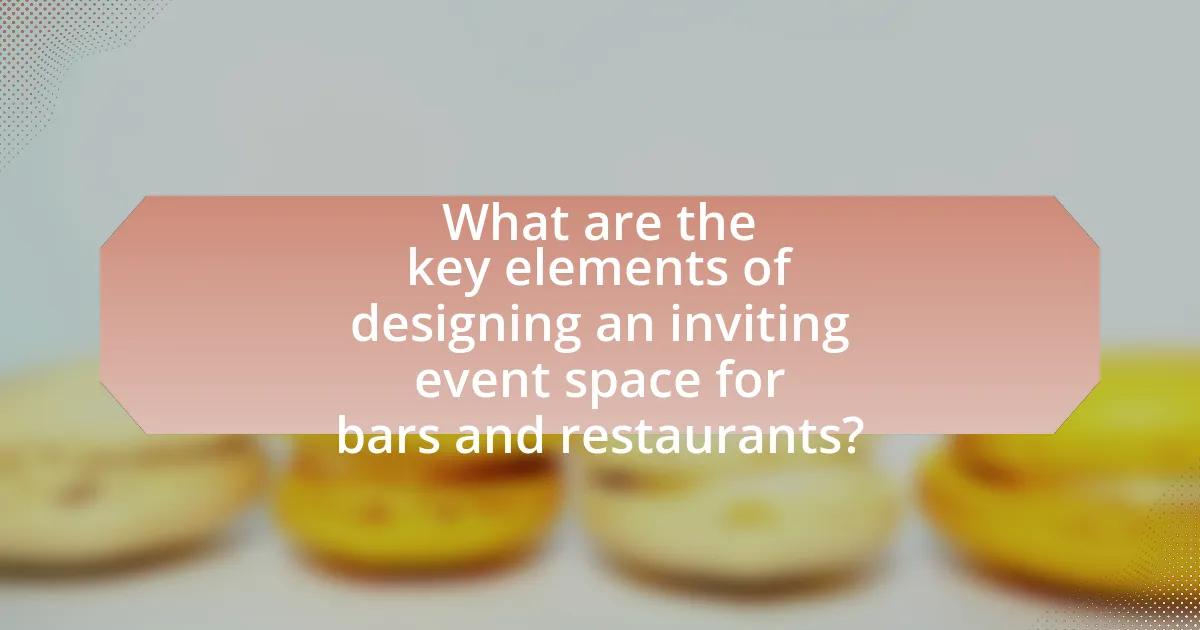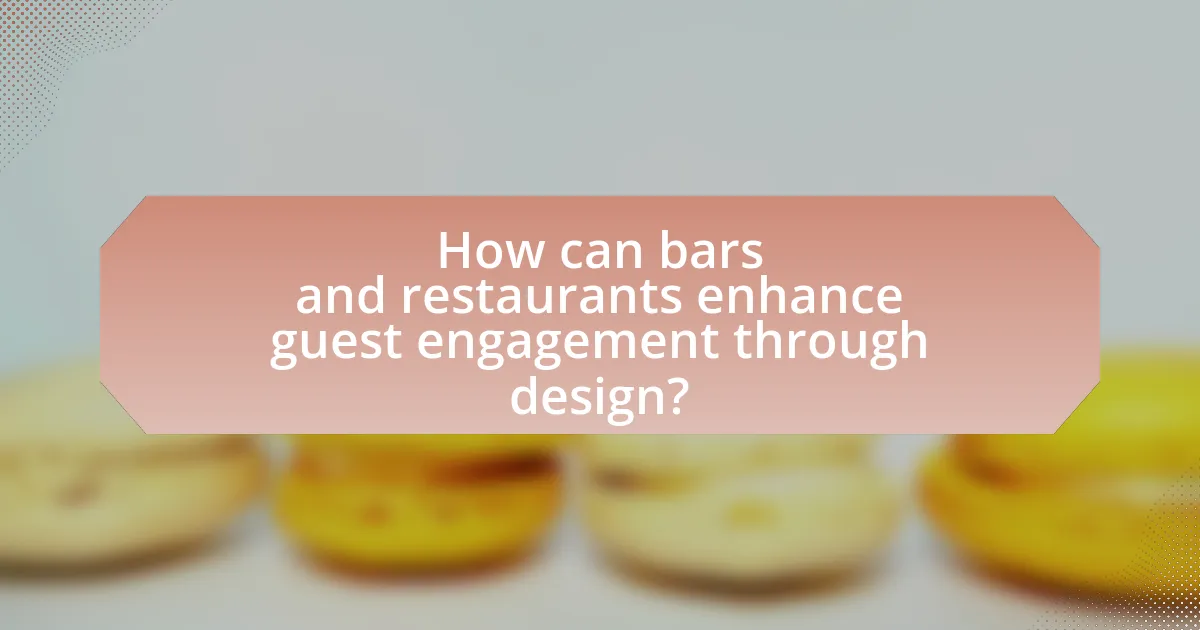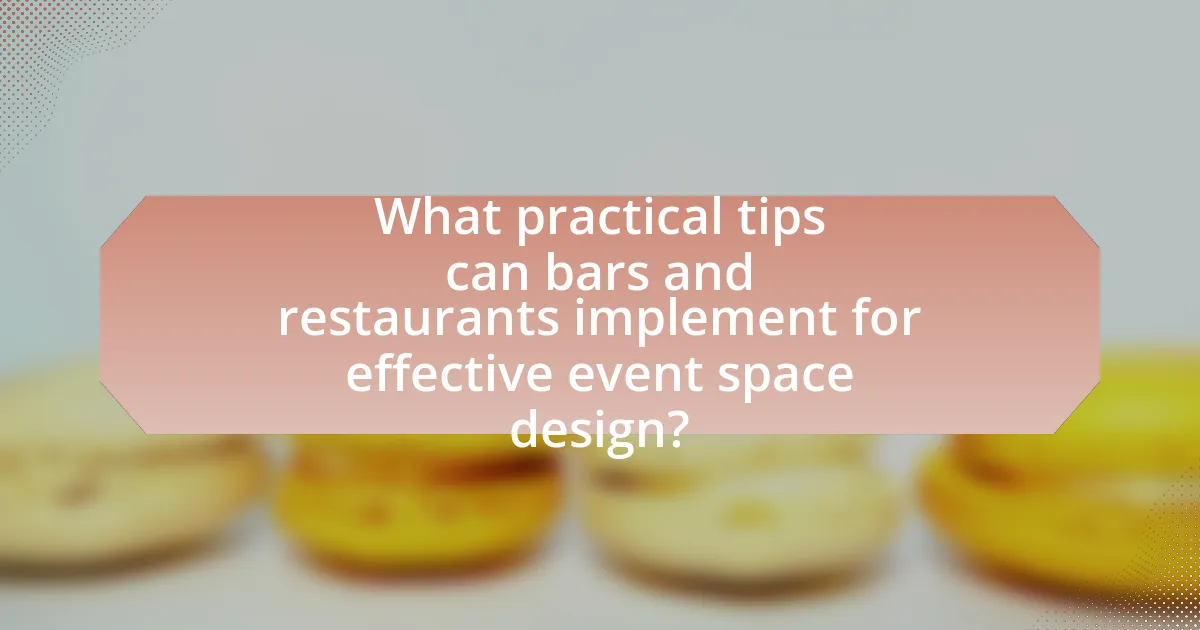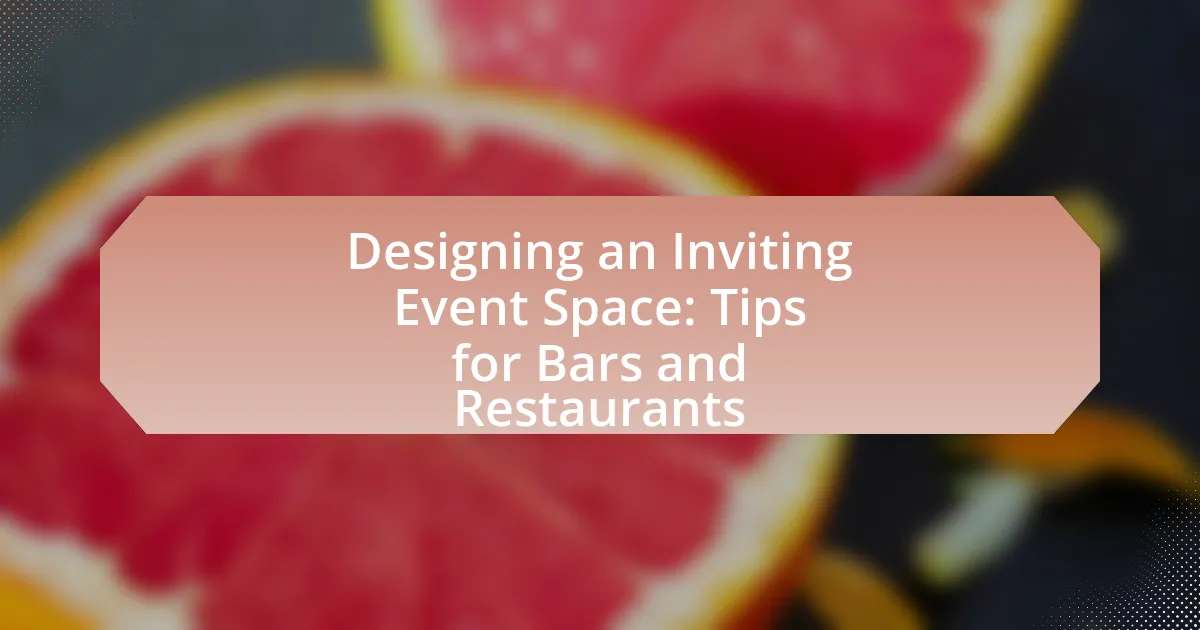The article focuses on the essential elements of designing an inviting event space for bars and restaurants, emphasizing layout, lighting, decor, and acoustics. It explores how ambiance influences guest experiences, detailing the impact of lighting and color schemes on mood and perception. Additionally, the article discusses layout considerations for maximizing comfort and space, the benefits of flexible seating arrangements, and design features that encourage social interaction. Practical tips for effective event space design, budget management, and common mistakes to avoid are also highlighted, providing a comprehensive guide for creating engaging environments that enhance guest satisfaction and retention.

What are the key elements of designing an inviting event space for bars and restaurants?
The key elements of designing an inviting event space for bars and restaurants include layout, lighting, decor, and acoustics. A well-thought-out layout facilitates movement and interaction, ensuring guests can navigate comfortably while engaging with each other. Effective lighting creates ambiance; studies show that warm, adjustable lighting enhances mood and encourages longer stays. Thoughtful decor, including color schemes and thematic elements, can evoke specific emotions and enhance the overall experience. Lastly, acoustics play a crucial role; managing sound levels through materials and design can prevent overwhelming noise, allowing for conversation and enjoyment. These elements collectively contribute to a welcoming atmosphere that attracts and retains customers.
How does ambiance influence the overall experience in event spaces?
Ambiance significantly influences the overall experience in event spaces by shaping attendees’ perceptions and emotions. A well-designed ambiance, which includes elements such as lighting, color, sound, and decor, can enhance comfort and engagement, leading to positive interactions among guests. Research indicates that environments with warm lighting and harmonious colors can increase feelings of relaxation and enjoyment, while appropriate sound levels can facilitate conversation and connection. For instance, a study published in the Journal of Environmental Psychology found that ambient factors can affect mood and behavior, demonstrating that a thoughtfully curated ambiance can elevate the overall satisfaction of guests in bars and restaurants.
What role does lighting play in creating an inviting atmosphere?
Lighting plays a crucial role in creating an inviting atmosphere by influencing mood and perception. Proper lighting can enhance the aesthetic appeal of a space, making it feel warm and welcoming. For instance, studies show that soft, warm lighting can increase feelings of comfort and relaxation, while harsh, bright lighting may create a sense of discomfort. Additionally, ambient lighting can highlight architectural features and decor, drawing attention to elements that contribute to the overall inviting experience. Therefore, effective lighting design is essential for bars and restaurants aiming to foster a pleasant environment for patrons.
How can color schemes affect guest perceptions and moods?
Color schemes significantly influence guest perceptions and moods by evoking emotional responses and shaping the overall atmosphere of a space. For instance, warm colors like red and orange can create a sense of excitement and warmth, encouraging social interaction, while cool colors such as blue and green promote calmness and relaxation. Research indicates that color can affect mood; a study published in the journal “Color Research and Application” found that colors can elicit specific emotional reactions, with red increasing energy levels and blue enhancing feelings of tranquility. Therefore, the strategic use of color schemes in bars and restaurants can enhance guest experiences by aligning the environment with desired emotional responses.
What layout considerations are essential for maximizing space and comfort?
Essential layout considerations for maximizing space and comfort in bars and restaurants include optimizing seating arrangements, ensuring clear pathways, and utilizing flexible furniture. Optimizing seating arrangements involves strategically placing tables and chairs to encourage social interaction while maintaining personal space; research indicates that a well-planned layout can increase customer satisfaction by up to 30%. Ensuring clear pathways allows for efficient movement, reducing congestion and enhancing the overall dining experience. Utilizing flexible furniture, such as movable tables and stackable chairs, enables quick reconfiguration of the space for different events, accommodating varying group sizes and activities. These considerations collectively contribute to a more inviting and comfortable environment for patrons.
How should seating arrangements be designed for different types of events?
Seating arrangements should be designed based on the specific requirements and nature of the event. For formal events, such as weddings or corporate meetings, a structured layout like rounds or theater-style seating promotes interaction and focus. In contrast, casual gatherings, such as parties or networking events, benefit from flexible arrangements like lounge seating or clusters of small tables, which encourage mingling.
Research indicates that the arrangement impacts guest interaction; for instance, a study by the University of Southern California found that open seating fosters more social engagement compared to traditional rows. Therefore, understanding the event type and desired guest experience is crucial for effective seating design.
What are the benefits of incorporating flexible space options?
Incorporating flexible space options enhances the functionality and adaptability of event spaces in bars and restaurants. This approach allows venues to accommodate various types of events, from intimate gatherings to larger celebrations, thereby maximizing usage and revenue potential. Research indicates that venues with flexible layouts can increase customer satisfaction by providing tailored experiences that meet diverse needs, leading to higher repeat business. Additionally, flexible spaces can reduce operational costs by minimizing the need for separate areas dedicated to specific functions, as one space can serve multiple purposes.

How can bars and restaurants enhance guest engagement through design?
Bars and restaurants can enhance guest engagement through design by creating inviting and functional spaces that encourage interaction and comfort. Thoughtful layout design, such as open seating arrangements and communal tables, fosters socialization among guests. Additionally, incorporating elements like ambient lighting, vibrant colors, and unique decor can stimulate a welcoming atmosphere, making guests feel more at ease and likely to stay longer. Research indicates that environments with engaging design can increase customer satisfaction and repeat visits, as evidenced by a study from the Cornell University School of Hotel Administration, which found that well-designed spaces significantly impact guest perceptions and behaviors.
What design features encourage social interaction among guests?
Design features that encourage social interaction among guests include open floor plans, communal seating arrangements, and strategically placed social zones. Open floor plans eliminate barriers, allowing guests to move freely and engage with one another. Communal seating, such as long tables or shared booths, fosters conversation among strangers and enhances the sense of community. Social zones, like lounge areas or fire pits, create inviting spaces where guests can gather and interact, promoting a more social atmosphere. Research indicates that environments designed for interaction can significantly increase guest satisfaction and encourage longer stays, ultimately benefiting the establishment’s overall success.
How can communal tables foster a sense of community?
Communal tables foster a sense of community by encouraging social interaction among patrons. These shared dining spaces create an environment where individuals can engage with one another, breaking down social barriers and promoting inclusivity. Research indicates that communal dining experiences can enhance feelings of belonging and connection, as people are more likely to strike up conversations with strangers seated nearby. For instance, a study published in the Journal of Environmental Psychology found that communal seating arrangements can lead to increased social bonding and a greater sense of community among participants.
What role do interactive elements play in guest engagement?
Interactive elements significantly enhance guest engagement by fostering participation and creating memorable experiences. These elements, such as games, live polls, and interactive displays, encourage guests to actively involve themselves in the environment, leading to increased satisfaction and longer stays. Research indicates that venues incorporating interactive features see a 30% increase in customer retention rates, as guests are more likely to return to spaces where they felt engaged and entertained.
How does the integration of technology improve the event space experience?
The integration of technology significantly enhances the event space experience by facilitating seamless communication and engagement among attendees. For instance, advanced audio-visual systems improve presentation quality, while interactive displays allow for real-time audience participation, making events more dynamic. Additionally, event management software streamlines logistics, such as registration and scheduling, which increases operational efficiency. According to a study by Eventbrite, 70% of event organizers reported that technology improved attendee satisfaction, highlighting its critical role in modern event planning.
What are the advantages of using digital displays for event promotion?
Digital displays offer several advantages for event promotion, including enhanced visibility, real-time updates, and engaging content. Enhanced visibility allows businesses to capture the attention of passersby with vibrant visuals, increasing foot traffic. Real-time updates enable event organizers to quickly change information, such as dates or special offers, ensuring that potential attendees receive the most current details. Engaging content, such as videos or animations, can create a more immersive experience, making events more appealing. According to a study by the Digital Signage Federation, 70% of consumers reported that digital signage influenced their purchasing decisions, highlighting its effectiveness in promoting events.
How can mobile apps enhance guest interaction during events?
Mobile apps can enhance guest interaction during events by providing real-time communication, personalized experiences, and interactive features. These applications enable guests to engage with event content, participate in live polls, and access schedules, which fosters a more immersive experience. For instance, a study by Eventbrite found that 70% of attendees prefer using event apps for networking and accessing information, demonstrating their effectiveness in facilitating guest interaction. Additionally, mobile apps can offer features like chat functions and social media integration, allowing guests to connect with each other and share their experiences instantly.

What practical tips can bars and restaurants implement for effective event space design?
Bars and restaurants can implement several practical tips for effective event space design, including optimizing layout for flow, ensuring adequate lighting, and incorporating flexible seating arrangements. An optimized layout facilitates movement and interaction among guests, which is crucial for events; studies show that well-planned spaces can enhance guest satisfaction by up to 30%. Adequate lighting creates the right ambiance and can influence mood, with research indicating that 70% of patrons prefer venues with adjustable lighting options. Flexible seating arrangements allow for customization based on event type, accommodating both small gatherings and larger parties, thus maximizing the utility of the space.
How can budget constraints be managed while designing an inviting space?
Budget constraints can be managed while designing an inviting space by prioritizing essential design elements and utilizing cost-effective materials. Focusing on key features such as lighting, color schemes, and furniture layout can create an inviting atmosphere without overspending. For instance, using warm lighting and a cohesive color palette can enhance the ambiance significantly, while sourcing furniture from local thrift stores or opting for multipurpose pieces can reduce costs. Additionally, incorporating DIY elements, such as handmade decorations or community art, can personalize the space and engage local talent, further minimizing expenses. Research indicates that well-designed environments can increase customer satisfaction and retention, making strategic investments in design even more valuable.
What are cost-effective materials and furnishings for event spaces?
Cost-effective materials and furnishings for event spaces include laminate surfaces, metal chairs, and modular furniture. Laminate surfaces are durable and easy to clean, making them ideal for high-traffic areas, while metal chairs are lightweight and stackable, allowing for flexible seating arrangements. Modular furniture offers versatility and can be reconfigured for different events, maximizing space efficiency. According to a study by the American Society of Interior Designers, using these materials can reduce costs by up to 30% compared to traditional furnishings, making them a practical choice for bars and restaurants looking to create inviting environments without overspending.
How can DIY elements contribute to a unique atmosphere?
DIY elements can contribute to a unique atmosphere by allowing for personalized and creative expressions that reflect the identity of the space. When bars and restaurants incorporate DIY decor, they can create distinctive environments that resonate with their target audience, enhancing customer engagement and satisfaction. For instance, using handmade furniture or locally sourced art can foster a sense of community and authenticity, which studies show can increase customer loyalty and repeat visits. A survey by Eventbrite found that 78% of consumers prefer venues that showcase unique, personalized touches, indicating that DIY elements can significantly impact the overall ambiance and appeal of an event space.
What are common mistakes to avoid in event space design?
Common mistakes to avoid in event space design include inadequate space planning, poor acoustics, and insufficient lighting. Inadequate space planning can lead to overcrowding or underutilization, negatively impacting guest experience. Poor acoustics can result in excessive noise or difficulty in communication, which detracts from the event’s atmosphere. Insufficient lighting can create an uninviting environment, making it difficult for guests to engage with the space and each other. These factors are critical as they directly influence the comfort and enjoyment of attendees, ultimately affecting the success of the event.
How can poor layout choices negatively impact guest experience?
Poor layout choices can significantly diminish guest experience by creating discomfort and hindering accessibility. For instance, a cramped seating arrangement can lead to feelings of claustrophobia, making it difficult for guests to move freely and enjoy their time. Additionally, poorly placed furniture can obstruct pathways, causing frustration and potential safety hazards. Research indicates that 70% of patrons prefer spaces that allow for easy navigation and social interaction, highlighting the importance of thoughtful design in enhancing overall satisfaction.
What should be considered to avoid overcrowding during events?
To avoid overcrowding during events, it is essential to establish a clear capacity limit based on the venue’s size and layout. This involves calculating the maximum number of attendees that can comfortably fit while ensuring safety and accessibility. For instance, the National Fire Protection Association recommends adhering to fire codes that dictate occupancy limits, which are often based on square footage and the number of exits available. Additionally, implementing a ticketing system can help control the number of guests, allowing for better crowd management. Monitoring guest flow and providing adequate space for movement are also critical factors in preventing overcrowding.


